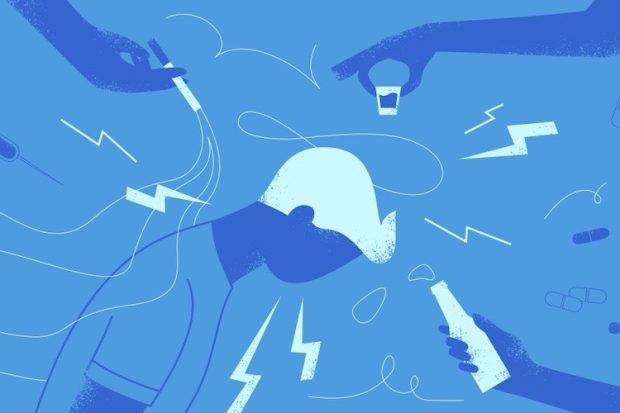Autism
Psychologist Helen Tager-Flusberg on theory of mind, comorbidity, and symptoms of autism

Migraine is a clinical syndrome characterized by headache with other features: migraine headaches tend to be one-sided, throbbing, or pulsing, and can be moderate or severe. They are always accompanied by other features – sometimes auras, which are usually visual displays that either precede the headache onset or begin with the headache, and sometimes with nausea and sensitivity to light or sound. The real hallmark of migraines is that there are recurrent attacks of headache, with these associated features, usually followed by pain-free periods where people return to relatively normal function.
You can divide migraines into types in two ways. First, you can define them as being with or without an aura. About 20 to 30% of migraine sufferers have attacks with an aura. Second, you can divide migraines by the frequency of attacks: chronic migraine is defined as 15 or more headache days per month, and episodic migraine is less than 15 headache days per month.
Migraine is an extraordinarily common condition by any standard, which affects about 18% of women and about 6% of men on a global basis. On that basis, there are nearly a billion people in the world – 959 million people – who suffer from migraine! In addition, the World Health Organization (WHO), which rates the disability associated with a variety of disorders using the Disability Adjusted Life Index metric (DALI), ranks migraine as the 7th leading cause of disability in the world, in part because each migraine attack produces admittedly temporary but still very significant disability, and in part, because the condition is so common.
Migraine is a lot more common in women than in men. Before the age of sexual maturation, it is a little more common in boys than girls. But at the age of menarche, when women’s periods start, it becomes more common in women and remains so throughout the rest of their lifespan. The median age of migraine onset is about 22, so most people get migraine before they make the transition to early adult life, with significant problems across the lifespan. There have been recent studies that suggest that colic in babies may be a form of migraine as well. Babies with colic are much more likely to have parents with migraine, and this finding has come out of the work of Peter Goadsby in the UK and Amy Galfand, a pediatric neurologist.
We’ve known about migraine since the time of the Egyptians and the Greeks. The Egyptians treated it by tying baby alligators to people’s heads. There’s also older evidence of treatment by trepanation (drilling a hole in the skull) because they thought the migraine was caused by evil spirits and by drilling a hole in the skull, the evil spirits would be let out. So there’s been a long history of research, though our understanding has shifted very substantially over the last 50 years. When migraine was first viewed as a disorder caused by evil spirits and later came to be viewed as a disorder caused by blood vessels, now it’s viewed as a substantially genetic disorder, and we know a lot about the genes that cause migraine. We believe that the underlying mechanism involves both the brain and blood vessels – so we consider it a neurovascular disorder, “neuro-“ meaning brain and “vascular” meaning blood vessels.
We have learned a lot from genetic studies. The evidence we have is multifaceted. One piece of evidence is that if you have a migraine, it’s much more likely that your relatives have it. Another piece of evidence comes from twin studies: identical twins are much more likely to both have migraine than fraternal twins. And from family studies and twin studies, you can estimate the extent to which a disorder is genetically determined – and both of these indicate that about 50% of influence is genetic and 50% is environmental. There are rare autosomal dominant forms of migraine, one of which is familial hemiplegic migraine. In this, there are neurological systems that precede the onset of an attack that consists of weakness on one side of the body. We’ve identified a number of genes that cause familial hemiplegic migraine, and all the genes that cause this have the effect of raising the levels of the brain chemical glutamate, which is the principal excitatory neurotransmitter in the brain. What that means is – when nerve cells communicate with each other, they do so chemically using brain chemicals that excite or inhibit their neighbors, and so the net effect of all the genes that cause FHM is to elevate the chemical glutamate. This is part of the reason we think of migraine as a disorder of increased brain excitability.
There are a number of risk factors that have been identified that make it more likely that a person will have a susceptibility to migraine – recurring events over a period of their lives – and then there are environmental factors associated with triggering a migraine attack.
Risk factors for having the disease include being female, having age – migraine is most common between the ages of 25 and 55 (peak productive years), and having a low socioeconomic status background. We’ve found that people with low education and low income are more likely to have migraine. It’s more common in Caucasians, less common in African Americans, and even less common in those of Asian background. It may be connected to racial differences and genetics, but it may be related to environmental factors as well.
In terms of cultural factors, measuring the extent of acculturation is certainly important. We didn’t study how long people had been in the United States, but international studies show similar patterns among these groups. We do know that people with high stress have more attacks than low-stress people. We also know from daily diary studies that stress and relaxation after stress increase the probability of having a migraine.

As for trigger factors, there are many of these. These are defined as factors that, on a short-time basis, increase the risk of migraine over a relatively brief period. The thing about triggers is that they vary from individual to individual. So it’s a long list – if you suffer from migraine, you have to think not that you have to avoid everything on the list; it’s rather figuring out which of these things may be connected to your headache.
Some common triggers include drinking alcohol, particularly red wine, stress, and relaxation after stress. In many women, having a menstrual period is a trigger, and in women with migraine who are having periods, migraines are most common from a couple of days before to a few days after the onset of bleeding. There are a number of other dietary factors – in some people, it’s artificial sweeteners, nitrates, nitrites, and cheese, for instance. There are a number of smartphone apps in development that allow people to record triggers to help them connect specific environmental factors in relation to headaches.
It’s worth saying that a migraine attack is typically divided into 4 phases, none of which is obligatory. The first phase is the promontory. It typically precedes migraine onset by hours or days. Typical symptoms can include increased or decreased energy, elevated or depressed mood, cravings for certain types of food, restlessness, neck pain, abdominal symptoms, and so forth. About two-thirds of migraine sufferers report these promontory features. The second phase is the aura. This includes photo effects and typically precedes migraine onset by 20 minutes. Most common effects are visual, typically zigzag lines. Symptoms typically develop slowly over minutes, and a visual aura often expands to encompass a greater and greater proportion of the visual field. However, an aura can also be sensory – tingling, numbness in the hands or feet; it can also be motor, where people get weak, as in the familial hemiplegic type of migraine. Only about 30% of people have auras, and people with auras are much more likely to go to a doctor and get diagnosed, unlike people who don’t have auras. The third phase is the headache phase. This is characterized by one-sided throbbing or pulsating pain – it can be on both sides of the head, but classically it’s on one side – and pain is usually moderate or severe. It’s in this phase where people usually develop nausea and sensitivity to light, sound, and smell. Almost everyone gets a headache, but some don’t. The fifth phase is the postdrome phase, after the pain resolves. People may report changes in mood or behavior, and they may have residual tenderness in the area where they had the pain; for instance, it may be painful to touch the temple or to lay your head on a pillow.

When it comes to treatment, there are acute treatments that people take when they get an attack in order to reduce pain and restore function, and there are preventive treatments that are taken on a daily basis to reduce the chance of getting a headache. Among both acute and preventive treatments, there are natural products, herbs, and vitamins, some of which have rigorous scientific evidence establishing that they work, there are pharmaceuticals, and there are also a number of devices used for treating migraine, three of which are FDA-approved for various indications in the United States.
Treatments can be divided into nonpharmacological and pharmacological, and one also can include neuromodulatory treatments. Among nonpharmacological treatments, one of the most important things to do is to look at lifestyles, and this can be very helpful. Many of these focus on factors that are triggers. These include things like getting the right amount of sleep v.s too much or too little, perhaps going to bed and waking up at the same time. Some people have food as a trigger; for instance, caffeine is a trigger, and I advise this to be limited to 1-2 cups of coffee a day. Sometimes people will have several cups of coffee on weekday mornings after they wake up, but on the weekends, they sleep through this, and then they can get caffeine withdrawal symptoms in combination with altered sleep patterns. In addition, if you have specific triggers, it’s useful to avoid them. It’s necessary to pay attention to the individual pattern with these. For people for whom stress is a trigger, this requires stress management which involves planning how to avoid it. Techniques include mindfulness meditation, yoga, and biofeedback, which is essentially an enhanced stress management technique.
One issue with acute treatments is that after people use acute treatments for a while, the treatments become less effective. There are two crucial and somewhat contradictory aspects of acute treatments. First, they work best early on in an attack when the pain is mild. The second aspect has to do with a phenomenon that comes with migraine called allodynia, in which ordinary stimuli become painful. For instance, things like the weight of an earring or putting one’s head on a pillow, taking a shower – things that wouldn’t hurt under normal conditions. About 2/3 of migraine sufferers develop allodynia during the course of an attack. So with acute treatment, it’s best to treat it while the pain is still mild and before allodynia develops. The big message is to treat early. And the second message is to not take acute treatments more than two to three times a week, as they may lose effectiveness and make the pain worse. So to reconcile this contradiction, we recommend taking preventative treatments to reduce the frequency of headaches.
The other major thing to say is that some people with migraine, particularly those who have prominent nausea, may not absorb the medication. This is the reason why there are nasal sprays and suppositories. People with prominent vomiting and nausea need non-oral therapies; it’s an important option for some people.
Among acute preventatives, there are muscle relaxants and anti-nausea medications to treat both nausea and pain, but NSAIDs and triptans are the most widely used treatments. There are five FDA-approved drugs, as well as drugs in other countries that are not approved in the US. In the United States, these include beta-blockers, which were originally developed to treat high blood pressure, but it was found that they can help with migraine, just by coincidence. There are two anti-epilepsy drugs, and in the US, the fifth drug is Botox, which has been approved for chronic migraine but not episodic migraine.
Then in addition, calcium channel blockers are sometimes used for migraine; flunarizine is one such, it’s widely used in Europe and Canada, but it’s not available in the US, unfortunately. In the US, there is verapamil, which I think is effective, but many people think it’s not a great drug, and certainly, the evidence supporting its effectiveness is limited.
There are also natural products, and there is good evidence suggesting that they work preventatively. Perhaps, the most widely used preventative vitamin is riboflavin (B2), which works in doses of 200mg twice a day. There is some evidence that magnesium works, as also coenzyme q10, and some evidence for other natural products as well.
With the currently available preventative treatments, one problem is that you have to take drugs for 6-8 weeks in order for the benefits to accrue, and some have very significant side effects. Part of the reason for the fact that it takes a while for the drugs to work is that you have to gradually increase the dose until it reaches the most effective level. So the preventive drugs we have are a little cumbersome and are generally recommended for people who have four or more headaches a month and significant headache disability. Of the 38% of Americans who meet the criteria for getting preventative treatment, only 12% get it, so preventatives are underutilized to what guidelines recommend. If they were more widely used, we would have more data.
There’s a lot happening in new therapies. On the acute treatment side, one of the areas of advancement is figuring out how to get triptans in more quickly without giving an injection to people who don’t absorb the drug well during attacks. There’s a new intranasal device for sumatriptan that works more quickly than tablets and is absorbed well even if the digestion system of paralyzed. It’s not well-absorbed in a liquid spray, but this dry powder is quite effective. There are new formulations to help get it in more quickly through the nose that is not yet available but should be short. One of the issues with triptans and non-steroidal inflammatories is that there is an increased risk of cardiovascular problems. Triptans can strip blood vessels, and NSAIDs seem to accelerate the development of the hardening of the arteries.
There are two main strategies at the moment to address cardiovascular safety. One is a drug called Lasmiditan which doesn’t constrict blood vessels. Two studies have shown that it’s effective, and the approval could happen within a year. There’s another class of compounds that are called CGRP, calcitonin gene-related peptides. Again there are a number of those that are thought to be free of the cardiovascular risks of triptans in development, but these are further away from the market than Lasmiditan.
On the prevention side, the really big deal, the one that everyone is excited about, is a class of drug called CGRP monoclonal antibodies. These are being developed by four companies – Amgen, Lilly, Teva, and Alder. These are injectable compounds, given subcutaneously once a month or by intravenous injection every three months. There is a large number of studies on this compound from all four of these companies, and they are being shown to be quite effective on episodic and chronic migraine, plus they have very favorable tolerability profiles. For the currently available preventatives, depending on the drug, there can be side effects like dry mouth, weight gain, or loss, among others. For that reason, when someone starts on preventive medication, less than 20% remain on it after a year. That’s mostly because the drugs don’t deliver the benefits they’re looking for or because of these side effects. So the idea of more effective preventatives that don’t have much in the way of side effects is extremely exciting to all the clinicians and many of the patients who know about it because the preventative therapies thus far have been far better than nothing but fall far short of the ideal, as well.
The first of the companies to file for FDA approval is Amgen; the hope is their preventive agent will be available within a year. Amgen’s product has been studied in both chronic and episodic migraine, and I have to say these are the most exciting thing I’ve seen in my 30 years in headache medicine.
A lot of work is being done with devices vs. therapies. Currently, two are approved in the US. One of them is the Cefaly device, which is used at home. It stimulates the nerves above the eyes (superorbital nerves) and is used as a preventative, 20 minutes a day, usually at bedtime. It uses a method called neuromodulation, which stimulates the nerves to make them less reactive. It’s an approach that’s been demonstrated to reduce the frequency of migraine attacks, and it’s FDA-approved for preventative purposes. It is a form of transcutaneous electrical nerve stimulation (TENS).
The second device is another neuromodulatory agent called the E-neura. This uses a method called transcranial magnetic stimulation, or TMS. The user applies the device to the back of the head, where it delivers magnetic (not-electrical) stimulation. It is FDA approved, both for acute – if used when an attack is coming on, it relieves pain and shortens the length of the attack – and also a preventative when used on a daily basis. Its original approvals were for acute migraines, but in the last couple of months, it has also been approved for preventative purposes.
As a neurologist/epidemiologist, my focus is to study populations over time, looking at risk factors and transitions, but I also do some clinical trials. In my recent studies, where I’ve seen following people with migraine in communities over time, one example of a recent finding is that, as we previously knew, if you have a migraine, you might have other pain disorders (this is called comorbidity) as well. We found that if you have a migraine, you are more likely to have other pain disorders – back pain, musculoskeletal pain, etc. One thing I’m very interested in is – what drives the transition from episodic to chronic migraine – 2.5 %to 3% of sufferers per year will develop chronic migraine the next year. So these people are getting a whole lot worse. We’re looking at the factors that predict this transition. The aim is if we can identify the risk factors, we can develop a preventative strategy to prevent it from getting worse.
Those with chronic migraine are only 8% of all migraine sufferers, but chronic migraine patients constitute a hugely disproportionate part of the burden of the disease as measured by direct medical and productivity losses due to missing work, being underemployed, or being unemployed. To date, what we have found is a number of things that predict migraine worsening over time, including allodynia, pain elsewhere in the body, obesity, depression, anxiety, and asthma.
One thing these things have in common is that they are all associated with increased inflammation, and we know this is associated with pain worsening. The studies, to some degree, suggest that inflammation may be a predictor of migraine progression. Therefore, promoting weight loss, treating asthma, and giving inflammatory drugs may have a protective effect. However, I emphasize that we haven’t shown this yet. It’s only with obesity and depression that there’s evidence that intervention might improve things.
The bottom line is that traditional clinical trials identify and test pharmacological and neuromodulatory treatments, but in epidemiology, what we do is to identify preventative methods that help people to get better and also identify the risk factors to prevent the migraines from getting worse. In this respect, we are laying the foundation for identifying nonpharmacological treatments.
Many headache specialists say that 38% of migraine sufferers need preventatives, only 12% get treated, and after a year, 80% stop using the preventative treatments, either due to side effects or the treatment didn’t work, or didn’t work as well as people wanted them to. To some degree, for prescribers and to a great degree for patients, what matters is whether the benefits are worse than the adverse side effects. Most people make the judgment that it’s not worth it. We define success as a 50% reduction in headaches, but people think the treatments will prevent all of their headaches. The CGRP monoclonal antibodies that are coming to market will be more effective and have few side effects, but unfortunately, they will be very expensive, around $10,000 to $20,000 for treatment per year. Interestingly, monoclonal antibodies used in multiple sclerosis are $100,000 per year, and this is paid because it’s perceived as a serious disease. Because migraine is not perceived as serious, there will be a reluctance to pay, even though on the WHO list of causes of disability, migraine is much higher than MS. We have some thinking to do about where we put scarce healthcare dollars and how we prioritize treatments. I want to be able to treat my patients; I see a lot of people who have their lives wrecked by migraine.
Edited by Kathleen White

Psychologist Helen Tager-Flusberg on theory of mind, comorbidity, and symptoms of autism

Neuroscientist Neil Burgess on the discovery of place cells, spatial memory, and experiments with functional n...

Physicist Srinivas Sridhar on non-invasive methods of monitoring, localizing the source of seizures, and brain...